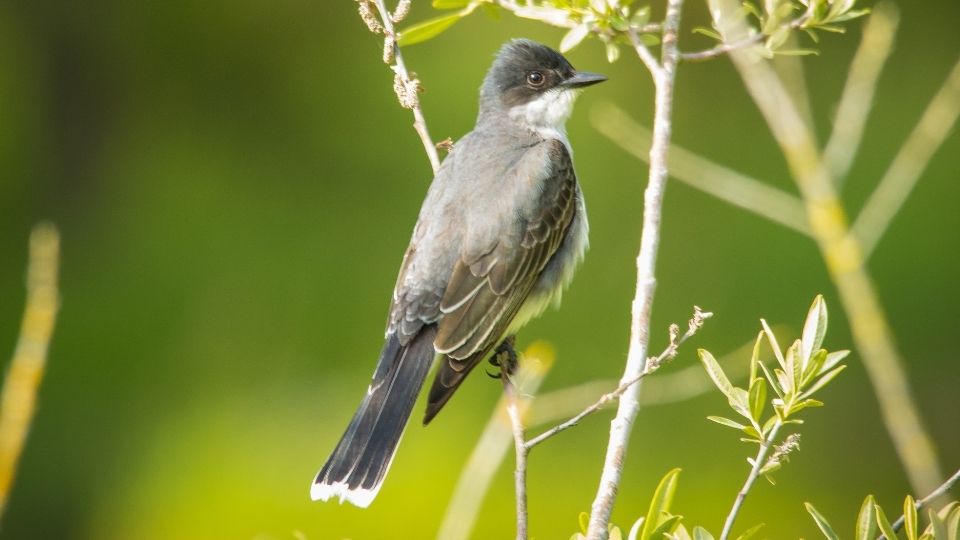Kingbirds are Passeriformes from the Tyrannidae or tyrant flycatcher family. Kingbirds are found predominantly in the US, and frequently migrate south towards central and south America. The Eastern and Western kingbirds are the most commonly seen in the US.
There are a total of 8 types of kingbirds that spend at least part of their year in North America. The kingbird gets its name from the hidden feathers beneath its cap of plain gray, brown, or black feathers. When agitated, the kingbird fluffs the feathers on its head, revealing a crown of red, orange, or bright yellow feathers.
Kingbirds prefer open habitats like woodlands and grasslands. Kingbirds have thick bodies and strong, broad beaks. Kingbirds are excellent flycatchers. They will perch in trees, on roadside fence lines, or on utility poles, waiting for the perfect moment to snatch a flying insect from the air. Tyrant flycatchers wait for prey on perches, snatching flying insects right out of the air.
Kingbird Species
While each of the 8 bird species of kingbirds have a defined range map and unique appearances, a few types of kingbirds share similarities. From the kingbird species with bright yellow bellies to their overlapping breeding ranges and love for open areas, we’ll cover the differences between all 8 kingbirds. With these critical identifiers, you’ll be able to tell these bold and graceful birds apart in no time.
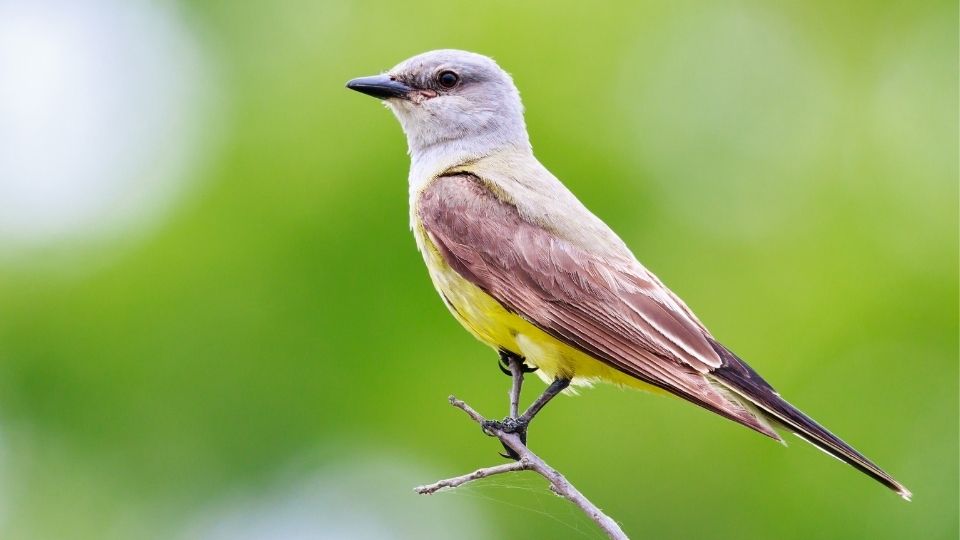
Western Kingbird Tyrannus Appearance and Range
The Western kingbird is a gray bird with dark grayish brown wings and a bright yellow belly. Western kingbirds also have white edges on their black tail feathers. The western kingbird has a large frame with a 15.5-inch wingspan.
Western kingbirds, suggested by their name, dwell and nest throughout western North America. Their breeding range runs from the southern Canadian border to northern Mexico. Outside the breeding season, they migrate to the Pacific Coast of Central America. Surprisingly, the Western kingbird can be found in Southern Florida in the winter, even though Florida is nowhere near the rest of the western kingbird’s range map.
Western kingbirds prefer open habitats with plenty of grassland spaces. They build their nesting sites in nearby shade trees. Breeding bird pairs are monogamous, with 1-2 broods per year. The female will incubate the 3-7 speckled whitish eggs while the male protects their territory.
Fun Fact: The western kingbird used to be called the Arkansas kingbird, even though this bird can be found in most of western North America.
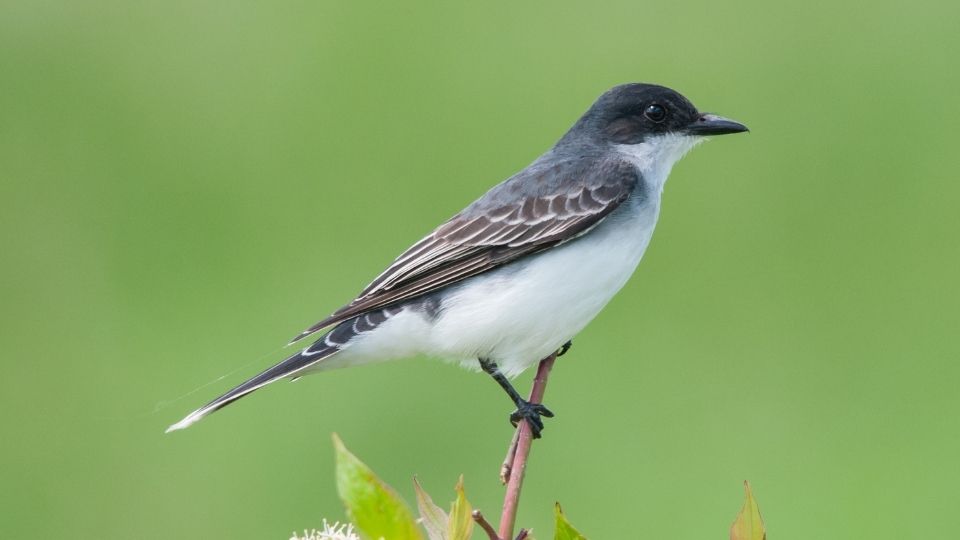
Eastern Kingbird Appearance and Range
While the Eastern kingbird shares quite a bit of its range map with the Western kingbird, the two birds look entirely different. The Eastern kingbird has a black-capped head with stout shoulders and black wings. The underside is white, as is the tip of its black tail.
The Eastern kingbird breeding range extends from Florida all the way up to northern Canada. There is significant overlap in the Great Plains states. During migration, the Eastern kingbird sticks to the Atlantic coast, Mexico, South and Central America, and Cuba. Winter is spent eating fruits in the Amazon area of South America.
Eastern kingbirds’ nesting sites can be found in trees. Unlike many Passeriformes, Eastern kingbirds care for their young for almost two months! This means breeding bird pairs usually only have one brood a year!
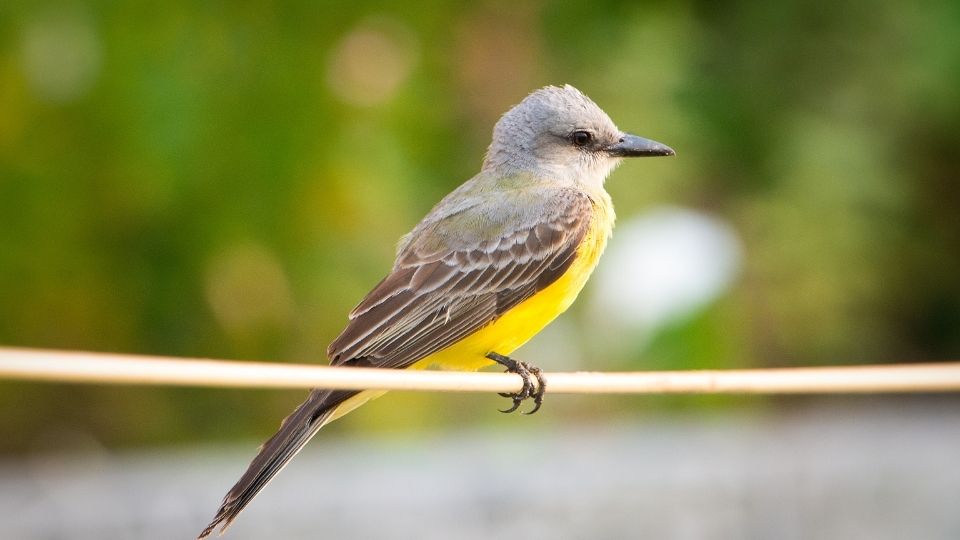
Tropical Kingbird Identification and Range
While the tropical kingbird and the western kingbird have bright yellow bellies, these similar species are easy to tell apart. Tropical kingbirds can have a dark or pale gray heads, but their yellow belly feathers extend further up to their neck. Tropical kingbirds occasionally dwell in a small area of the United States. While they briefly visit the Pacific Coast, most tropical kingbirds reside predominantly in South and Central America.
During the breeding season, the tropical kingbird nesting sites can be found in southern Arizona, southern Texas, and South America! Tropical kingbirds prefer to exist in woodland habitats with large open areas. Like all kingbirds, they catch primarily flying insects, but they also eat some fruits and will even catch small fish! You can typically find them near water sources, towns, and busy roadsides.
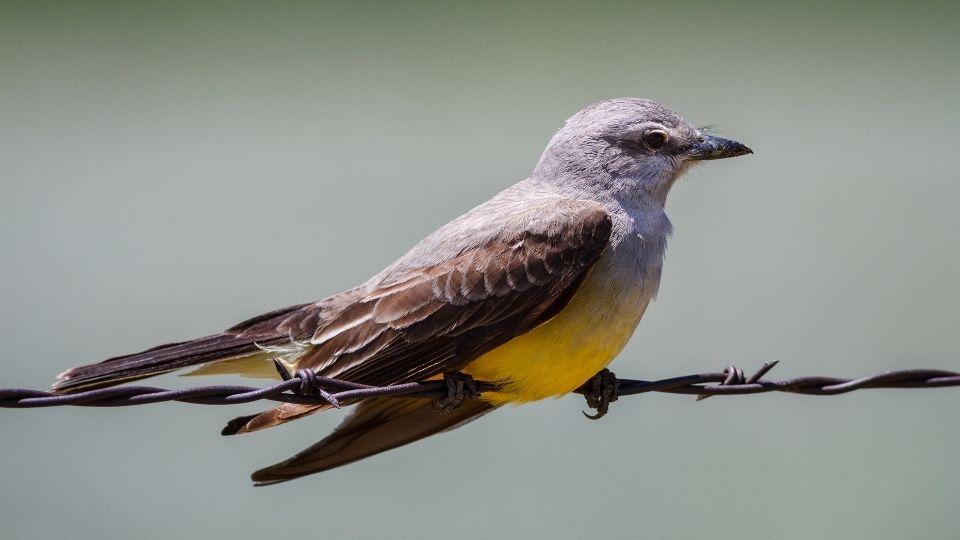
Cassin’s Kingbird Identification and Range
Cassin’s kingbird has a yellow belly and looks similar to the Western and Tropical kingbirds. Three distinct features set these birds apart, making them easy to tell apart in the few places where their range overlaps. The Cassin’s kingbird has gray feathers on its head and chest, it lacks the white edge on its tail feathers, and the Cassin’s kingbird has a whitish throat marking.
Cassin’s kingbirds spend most of the year in Mexico and a small area of southwestern California. Breeding birds spend summer months in the western United States desert areas, where they prefer open habitats with scattered trees. Cassin’s kingbirds are partial migrants, with some populations remaining year-round in Mexico.
Couch’s Kingbird Identification and Range
Couch’s kingbirds have dark gray heads, backs, and brownish gray feathers. The shoulders of the couch’s kingbird have a greenish cast with a bright yellow belly that extends all the way up to the neck. Couch’s kingbirds do not migrate and are found exclusively along the Gulf Coast, from southern Texas to the Yucatán Peninsula.
Couch’s kingbirds prefer thorny tree forests along streams and rivers. The Couch’s kingbird’s song has a very distinct call, which sounds like trip-trip-treeeeeee. The Couch’s kingbird used to be a subspecies of the tropical kingbird, but ornithologists in the 1960s noticed the vastly different calls of the two birds. In the 1980s, the couch’s kingbird was designated as a separate species from the tropical kingbird.
Thick-billed Kingbird Identification and Range
Thick-billed kingbirds are found in the southern borders of Eastern Arizona and Western New Mexico. The rest of the year, they are found on the Pacific Coast side of Mexico and into Guatemala. Thick-billed kingbirds perch high in sycamore and cottonwood trees and in open areas near streams and other permanent waterways.
Thick-billed kingbirds have an olive brown to a dark gray cap, back, and wings, with black or brownish gray tail feathers. They have a whitish to pale yellow belly. When the thick-billed kingbird ruffles its’ feathers, their crown is the same pale yellow.
As the name suggests, the thick-billed kingbird has the thickest bill of the kingbird species. Thick-billed kingbirds are excellent bug catchers like the rest of the tyrant flycatcher family, but the bigger beak allows them to eat large beetles and cicadas. Thick-billed kingbird nesting sites can be found high in sycamore trees–sometimes as high as 80 feet off the ground!
Gray kingbird Identification
Gray kingbirds have a slate of ashy gray heads and shoulders, with brownish wings and tail feathers. Their underparts are a soft whitish gray, and they have a dark gray eye line. Juveniles have cinnamon brown coloring and a white ring around their neck. Gray kingbird tails are notched in the center, giving them a near scissor-like tail.
Gray kingbirds in the United States are found on the eastern Louisiana coast and Florida coast during breeding season only. For the rest of the year, the gray kingbird population is found from the eastern edge of the Yucatán Peninsula throughout the Caribbean Sea coastlines and the Bahamas. In towns in the Caribbean, gray kingbirds are common backyard birds and great for insect pest control.
Gray kingbirds like open habitats on the coast, where they perch in mangroves to stalk flying insects. Gray kingbirds are masters of the chase, sometimes chasing flying insects over 100 yards before they snatch them out of the sky. Gray kingbirds are known to roost together in large flocks from dusk until dawn. This behavior is thought to be for safety from predators rather than social.
Loggerhead Kingbirds Identification and Range
The loggerhead kingbird looks a lot like the Eastern kingbird. The loggerhead kingbird is a dark gray head, shoulders, and tail, with a whitish underside, with pale yellow under its tail. The tail feathers are one of the more obvious physical features to differentiate the two. The loggerhead kingbird has some whitish coloring on the tips of the tail feathers, but it is a very small amount and not nearly as striking as the eastern kingbird’s tail.
During the Eastern kingbird’s migration, you may find these similar species sharing space in the Florida Keys and Cuba. Loggerhead kingbirds are non-migrant kingbirds found in the southern tip of coastal Florida, the Florida Keys, the Bahamas, and the Caribbean. Scattered populations can also be found in coastal areas of Central America and South America. Sightings on the mainland of South and Central America are very rare.
Fun Facts About Kingbirds
Kingbirds are known to boldly defend their territory from any bird that gets too close. They will chase away other kingbirds to defend their fellow kingbirds and territories. They even harass invading hawks, ravens, and other birds that are much larger than they are!
The scissor-tail flycatcher found in Texas and surrounding states is also part of the tyrant flycatcher family. It’s a close relative of kingbirds though it looks nothing like any other kingbird species. Kingbirds are great grasshopper control, especially western kingbirds. They love to hunt destructive insects and are more effective at controlling grasshoppers than poisons and sprays.
What is the conservation status of kingbirds?
All 8 species of kingbirds found in the United States have a conservation status of Least Concern. The giant kingbird, found only in Cuba, was added to the IUCN red list and is considered endangered. The giant kingbird’s small population continues to decline, putting the species in significant danger of extinction.
Of the 13 species of tyrant flycatchers, all but the giant kingbird have stable populations. Like all songbirds, kingbirds still face threats from urbanization, domestic animals, and natural predators. Still, this North American bird species have managed to survive.
It isn’t much known about the cause of the giant kingbird’s decline. This gorgeous gray and white kingbird is already completely extinct from 2 of Cuba’s islands. While habitat loss is largely to blame, Cuba’s closely related tropical kingbird population is still thriving.
Indentifying Kingbirds Summary
Kingbirds are one of the most entertaining birds in North America. These broad-billed master flycatchers are a delight to watch. They also help farmers and local flora by removing grasshoppers, locusts, and beetles. While they look similar, this bold bird’s key physical identifiers and behaviors make telling them apart a snap!

